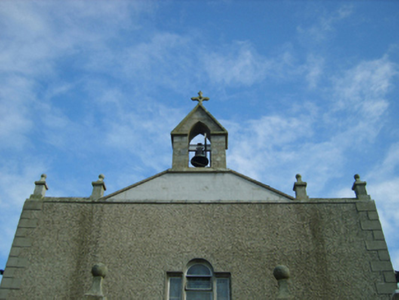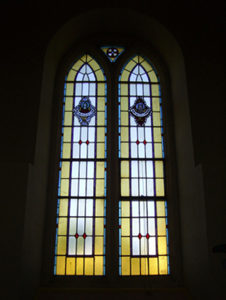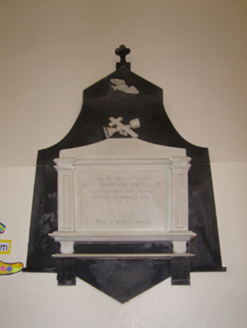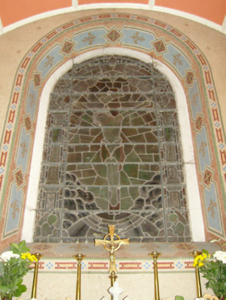Survey Data
Reg No
15704031
Rating
Regional
Categories of Special Interest
Architectural, Artistic, Historical, Social
Original Use
Church/chapel
In Use As
Church/chapel
Date
1835 - 1840
Coordinates
284207, 116851
Date Recorded
31/05/2009
Date Updated
--/--/--
Description
Detached four-bay double-height Catholic church, built 1839, on a rectangular plan originally three-bay double-height single-cell comprising three-bay double-height nave opening into single-bay double-height chancel (east) with single-bay single-storey projecting porch to entrance (west) front. "Improved", 1861, producing present composition. Renovated, 1981, with sanctuary reordered. "Restored", 2002. Pitched slate roof behind parapet with clay ridge tiles, coping to gable (east) with Cross finial to apex, coping to gable to entrance (west) front with cut-granite gabled bellcote to apex framing cast-bronze bell, and replacement uPVC rainwater goods on slightly overhanging rendered eaves. Gritdashed roughcast walls on rendered chamfered plinth; gritdashed roughcast surface finish to entrance (west) front on rendered chamfered plinth with rendered quoins to corners supporting parapet having pinnacle-topped cut-granite coping. Round-headed window openings with cut-granite sills, Y-mullions, and cut-granite surrounds having chamfered reveals framing fixed-pane fittings having stained glass margins centred on leaded stained glass panels. Round-headed window opening to chancel (east) with fixed-pane fitting having leaded stained glass margins centred on leaded stained glass panel. "Venetian Window" to gable to entrance (west) front with cut-granite sill, mullions, and concealed dressings framing storm glazing over fixed-pane fittings having stained glass margins centred on leaded stained glass panel. Round-headed window opening (porch) with cut-granite sill, and rendered "bas-relief" surround framing fixed-pane fitting having stained glass margins centred on leaded stained glass panel. Pointed-arch opposing door openings to "cheeks" with rendered "bas-relief" surrounds having chamfered reveals framing diagonal timber boarded or tongue-and-groove timber panelled double doors. Interior including vestibule (west) with stained glass window (undated); square-headed door opening into nave with replacement glazed timber double doors having sidelights; full-height interior with carpeted aisles between cruciform-detailed timber pews, paired timber stations between stained glass windows (undated), moulded plasterwork cornice to ceiling, and cut-veined white marble stepped dais to sanctuary (east) reordered, 1981, with round-headed chancel arch framing Gothic-style high altar below stained glass memorial "East Window" (----) in mosaic tiled surround. Set in landscaped grounds on a corner site with gritdashed roughcast boundary wall to perimeter having lichen-spotted "saddleback" coping.
Appraisal
A church representing an integral component of the built heritage of south County Wexford with the architectural value of the composition, one allegedly repurposing a chapel destroyed in the so-called "Night of the Big Wind" (1839; de Vál 2004, 57), suggested by such attributes as the compact rectilinear plan form, aligned along a liturgically-correct axis; the slender profile of the coupled openings underpinning a "medieval" Gothic theme with the chancel defined by a restrained "East Window"; and the simple bellcote embellishing the roofline as a picturesque eye-catcher in the landscape: meanwhile, aspects of the composition clearly illustrate the continued development or "improvement" of the church into the early twentieth century. Having been well maintained, the elementary form and massing survive intact together with substantial quantities of the historic or original fabric, both to the exterior and to the interior reordered (1981) in accordance with the liturgical reforms sanctioned by the Second Ecumenical Council of the Vatican (1962-5) where stained glass; a crocketed high altar; and the Hickey Memorial "East Window" attributable to Franz Mayer and Company (founded 1847) of Munich and London, all highlight the artistic potential of a church forming part of a neat self-contained group alongside an adjoining presbytery (see 15704032) and opposing graveyard (see 15704033) with the resulting ecclesiastical ensemble making a pleasing visual statement in a rural village setting presently (2007) undergoing extensive "suburban" development. NOTE: A streamlined "Venetian Window" recalling the stable complex at nearby Rosegarland House (see 15704041) suggests a shared architect or builder.





























